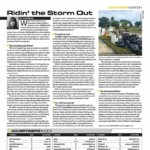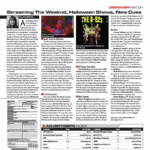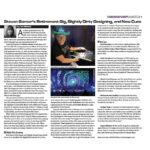Destroid is using hundreds of custom LEDs — not in the rig or lining the stage, but clothed on their bodies. The EDM group is outfitted with specially-made $100,000 body armor — complete with smoke machines, CO2 and laser arm blasters, custom LED panels and animatronics and built-in video cameras feeding live visuals. That doesn’t even take into account the rest of the production. LDs Michael Smalley and Kyle Kegan worked together on the show for the group, which is performing at some summer festivals and is planning to embark on a major tour in the fall.
Atlanta-based Smalley, the current LD for the rock band Stone Sour, also designs for Papa Roach and In This Moment. He’s also been the LD for Bassnectar. Kegan is the LD for Major Lazer. Destroid consists of DJ Excision and DJ Downlink, with drummer KJ Sawka of Pendulum. We spoke with Smalley about the big idea, the theme the band describes as “electronic devastation and cerebral elevation.”
 PLSN: What sparked the special suit idea?
PLSN: What sparked the special suit idea?
Michael Smalley: The band did that on their own. By the time Kyle and I were brought in, they had already had these well into development.
What input did you have regarding the control and lighting of the suit?
In the building process, we in the lighting department just coordinated with the fabricators to make sure we could have the most control. The suits uses wireless DMX and have literally hundreds of LEDs in them. For the sake of keeping the counts down to a single universe per suit, we paired up some sections of the suit. We made pairs on the legs and shoulders mostly, and things were matched horizontally, which gave us the ability to have vertical pixels be separate.
 Do the custom guitars control the suits?
Do the custom guitars control the suits?
Not exactly. Through a custom piece of software my friend Matt Davis came up with, the MIDI (Musical Instrument Digital Interface) triggers on the custom guitars could be turned directly into Art-Net and sent to our desk. The same thing with each of the MIDI drums in the drum kit. This enables the band to trigger their cryo blast, which is DMX controlled, as well as lasers in their helmets. In the future progressions of the show’s programming, the band will be able to trigger all sorts of events in the show, from lighting to strobe effects, all from their guitars or playing the drums.
How did the suits affect your stage lighting design?
I found it to be liberating. The suits could be wildly expressive and really capture the more glitchy elements of the music. It allowed me not to have to use strobes and all that flashy stuff every time the band went crazy. What really affected us was the use of projection. We had awesome soft goods for this show and then projected onto them animations made specifically for the backdrops. We used these as transitionary elements throughout, and I absolutely loved it. Making the adjustments on the “volume” of the lights to accommodate the video was done real-time, using inhibitors.
 How did you two collaborate on the production design?
How did you two collaborate on the production design?
Because of our own intense touring schedules, we had to coordinate while overseas and doing shows every day sometimes. It was a serious task. Kyle and I come from a pretty similar design ideology. We had a few Initial conversations together and with the band to grasp the design aesthetic. We wanted the physical structure of the rig to be asymmetrical while preserving even-numbered fixture counts. From a programming standpoint I find even sets of fixtures are easier to program, and from a design perspective I’m pretty dead set on having even counts. Even fixture counts also make the show easier to adapt to various festival rigs. Maybe that’s the box I have yet to really step out of. I wanted this project to be something new for me along the entire road to the actual show.
Kyle was the brave soul to hop on the actual plotting. He’s much better at that than me.
How did you program the suits and the show?
I took on the challenge of building the initial show file that we would use to program the show. I was able to squeeze in two days of patching and palette building at my home studio before heading to Japan for a gig with Stone Sour.
Kyle and I met up a week later in San Francisco. We set up a console in the hotel room and wysiwyg on the TV. We then worked in shifts for the next six days for well over 18 hours a day of cue stacking. We decided we would cue stack every song, then once on site we would execute the Cuestacks while recording Timecode. It was an extremely difficult task. We were averaging about and hour to two hours of programming for every minute of music. Some sections were obviously easier, but most were a pretty serious investment of time and mental energy.
Kyle and I really worked in congress on this, with each of us taking one of the two really time-consuming parts on the front end: plotting, and the show file build.
And in the end?
When this project came along it was pretty perfect. It was a chance to bring in a bunch of ideas from our other projects. We were both seeking an outlet for a different tilt on what we were doing.
Ravitz Wins Regional Emmys
LD Jeff Ravitz has won two regional Emmy Awards for Outstanding Lighting Design by both the Pacific Southwest and the Michigan chapters of the National Academy of Television Arts and Sciences (NATAS). The awards recognized the role he played in A Salute To Teachers 2012, which was produced by Channel 4 San Diego for the Cox Cable Network, and A Celtic Awakening, Featuring Faith Marion Robinson, which was presented by Detroit Public Television and carried by local and national PBS affiliates. Describing the design of the two shows, Ravitz said the teacher awards program “combined traditional awards presentations with musical entertainment.”
A Celtic Awakening, which took place in Detroit’s Masonic Temple, had some design challenges, Ravitz noted. “There are no standard lighting positions in that space. We had to create temporary, ground-supported mounting locations for all our fixtures, but, of course, the producers wanted the equipment to be unseen by the cameras. That was quite a challenge, and there were times that finding optimum lighting trumped fixture invisibility. Nevertheless, I think we were as discreet as possible to avoid blocking the architecture.”
Quick Cues…
LD Chris Lisle designed, programmed and is running the “Robert Plant Presents the Sensational Space Shifters” tour, while LD Joe Paradise is doing the same for 311…Glenn Felton is the PM/LD for Frampton’s Guitar Circus featuring Peter Frampton and a variety of renowned fellow guitarists…Rod Stewart’s “Live the Life” tour recently got underway with set design by Paul Staples and lighting by LD Mark Payne, with Lars Brogaard serving as production manager…LD Paul Hoffman is out again with Widespread Panic, a gig he’s had since 2009…LD Simon Tutchener is out with Mark Knopfler…LD Larry Morin continues on with Cheap Trick this summer…LD James Thompson designed The Script’s current world tour. He was recognized with a Knight of Illumination Award for his work with the band in 2011.
What did you do/are you doing on your summer touring “vacation” on your time off? Tell Debi Moen all about it for the August issue. Send an email to dmoen@plsn.com.


